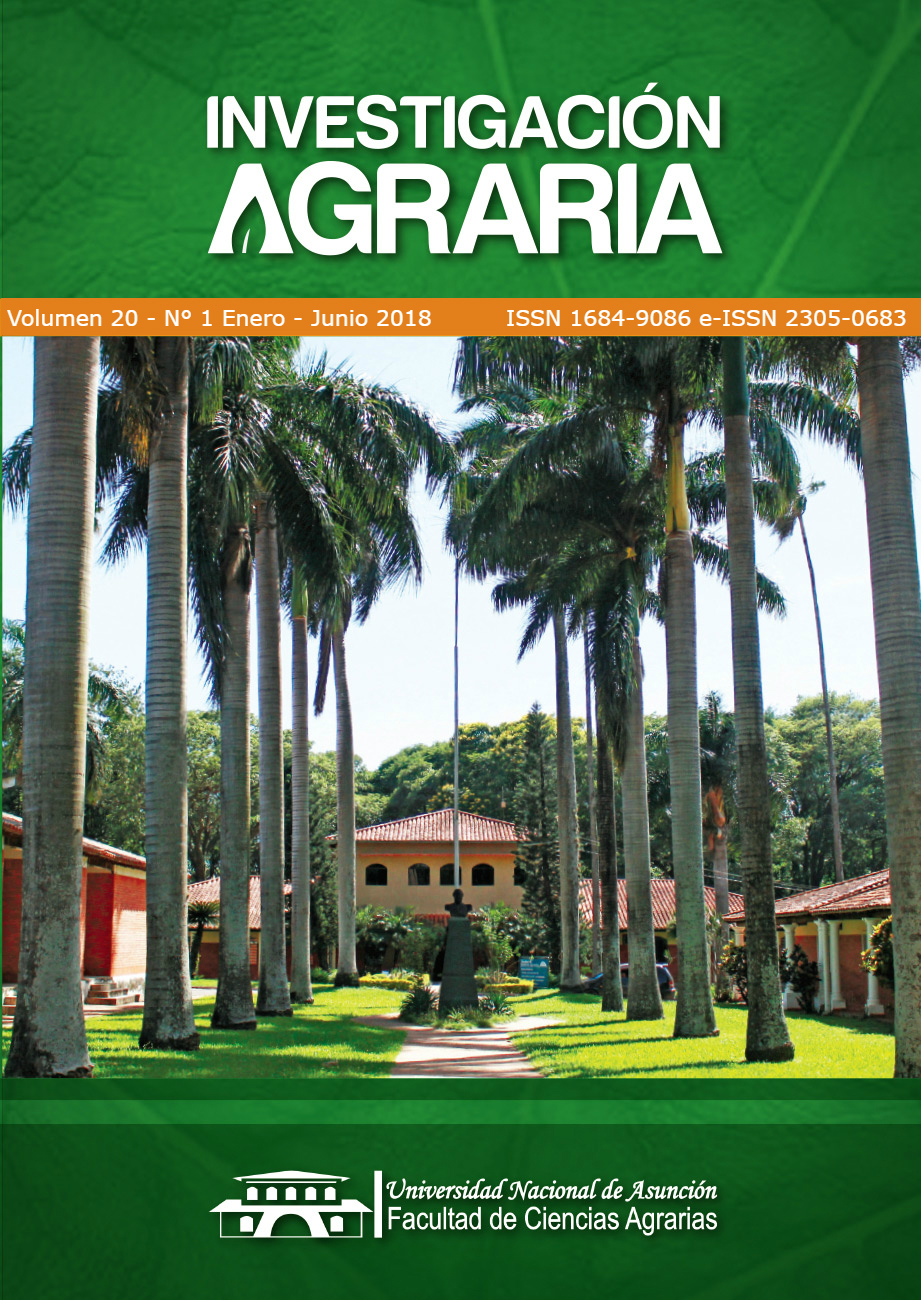Seeds of Salvia hispanica L., "chia" as a source of macronutrients, dietary fiber and minerals
DOI:
https://doi.org/10.18004/investig.agrar.2018.junio.74-77%20%20Keywords:
dietary fiber, macronutrients, minerals, Salvia hispanica L., seedsAbstract
The purpose of this research was to determine the content of macronutrients, dietary fiber, moisture and minerals in Salvia hispanica L.’s seeds. Moisture determination was carried out in a conventional oven until constant weight, proteins by the kjeldahl method, lipids by soxhlet, dietary fiber by the enzymatic gravimetric method and minerals by atomic absorption equipment, the anthrone colorimetric method was used for carbohydrates and the caloric value was determined by calculations. From the results, it can be informed that chia`s seeds have a significant content of dietary fiber 41.4 ± 1.20 g/100 g, lipids 22.3 + 0.283 g/100 g, protein 17.2 + 0.436 g/100 g and carbohydrates 8.46 ± 0.085 g/100 g. The minerals founded in greater concentration were potassium 617 ± 26.6 mg/100 g, calcium 532 ± 15.1 mg/100 g, magnesium 81.5 ± 2.25 mg/100 g, iron 10.8 ± 0.636 mg/100 g, in lower concentration sodium 8.97 ± 0.82 mg/100 g and zinc 4.03 ± 0.09 mg/100 g. Chia`s seeds stand out as a source of dietary fiber, potassium, calcium, magnesium and iron. Its low level of sodium makes it suitable for diets with low sodium intake. The consuming of chia seeds could contribute to a varied and healthy diet.Downloads
Metrics
References
Ayerza, R. 2013. Seed composition of two chia (Salvia hispanica L.) genotypes wich differ in seed color. Emirates Journal of Food and Agriculture. 25 (7): 495-500.
Busilacchi, H; Quiroga, M; Bueno, M; Di Sapio, O; Flores, V; Severin, C. 2013. Evaluación de Salvia hispanica L. cultivada en el sur de Santa Fe (República Argentina). Revista Cultivos Tropicales. 34 (4): 55-59.
Cuevas, Z; Sangonis, E. 2012. Caracterización de semillas de linaza (Linum usitatissimun L.) cultivadas en Venezuela. Archivos latinoamericanos de Nutrición. 62 (2): 192-200.
FAO (Food and Agriculture Organization of the Unite Nations, Italia). 1997. Grasas y aceites en la nutrición humana. Italia: Depósito de documentos de la FAO. Roma, Italia Disponible en: http://www.fao.org/docrep.
Gutiérrez, R; Ramírez, L; León, S; Fontecha, J; Rodríguez, L; Escobar, A. 2014. Fatty acid content in chia (Salvia hispanica L.) seeds grown in four Mexican states. Revista Cubana de Plantas Medicinales. 19(1): 199-207
Hernández Gómez, JA; Miranda Colin, S. 2008. Morphological characterization of chía (Salvia hispanica). Rev. Fitotec. Mex. 31(2): 105-113
Horwitz, W. 2000. Official methods of analysis of AOAC International. 17th ed. Gaithersburg, Maryland, AOAC International.
Jiménez, P; Masson, L; Quitral, V. 2013. Chemical composition of chia seed, flaxseed and rosehip and its contribution in fatty acids omega-3. Revista Chilena de Nutrición. 40(2): 155-160.
MERCOSUR. 2005. Reglamento Técnico MERCOSUR sobre rotulado nutricional de alimentos envasados. Resolución conjunta SPR y RS 149/2005 y SAGP y A 683/2005. MERCOSUR/GMC/RES. N° 46/03.
Ministerio de Sanidad, Consumo y Bienestar Social, España. 2006. Reglamento (CE) N° 1924/2006 del Parlamento Europeo y del Consejo de 20 de diciembre de 2006. Declaraciones nutricionales y propiedades saludables en los Alimentos.17 p.
Muñoz, L; Cobos, A; Díaz, O; Aguilera, J. 2013. Chia seed (Salvia hispanica L.): An Anicient Grain and a new Functional Food. Food Reviews International. 29: 394-408.
Norlaily, M; Swee, K; Wan, Y; Boon, K; Sheau, W; Soon, G. 2012. The Promising Future of Chia, Salvia hispanica L. Journal of Biomedicine and Biotecnology. 17: 1-9.
Osborne, DR; Voogt, P. 1986. Análisis de los Nutrientes de los Alimentos. Zaragoza, España, Editorial Acribia.
Porras, P; Jiménez, M; Sosa, M; Palou, E; López, A. 2014. Phisycal properties, chemical characterization and fatty acid composition of Mexican chia (Salvia hispanica L) seeds. International Journal of Food Science and Technology. 49: 571-577.
Rovati, A; Escobar, E; Prado, C. 2012. Particularidades de la semilla de chía (Salvia hispanica L.). EEAOC (Estación Experimental Agroindustrial Obispo Colombres). Avance Agroindustrial 33(3): 39-43.
Tavares, L; Tavares, L; Leite, R; Oliveira, C; Silva, A. 2015. Chia induces clinically discrete weight loss and improves lipid profile only in altered previous values Rev. Nutr. Hosp. 31 (3):1176-1182.
Vázquez-Ovando, JA; Rosado-Rubio, JG; Chel-Guerrero, L; Betancour-Ancona, DA. 2010. Procesamiento en seco de harina de chía (Salvia hispanica L.): caracterización química de fibra y proteína. Journal of Food 8(2): 117-127.
Vuksan, V; Jenkins, AL; Dias, AG; Lee, AS; Jovanovski, E; Rogovik, A; Hanna, A. 2010. Reduction in postprandial glucose excursion and prolongation of saciety: possible explanation of the long-term effects of whole grain Salba (Salvia hispanica L.). European Journal of Clinical Nutrition. 64(4): 436-438.
Downloads
Published
How to Cite
Issue
Section
License
Copyright (c) 2018 Investigación Agraria

This work is licensed under a Creative Commons Attribution 4.0 International License.
All content in this journal is under Creative Commons Attribution License.









 All content in this journal is under
All content in this journal is under 